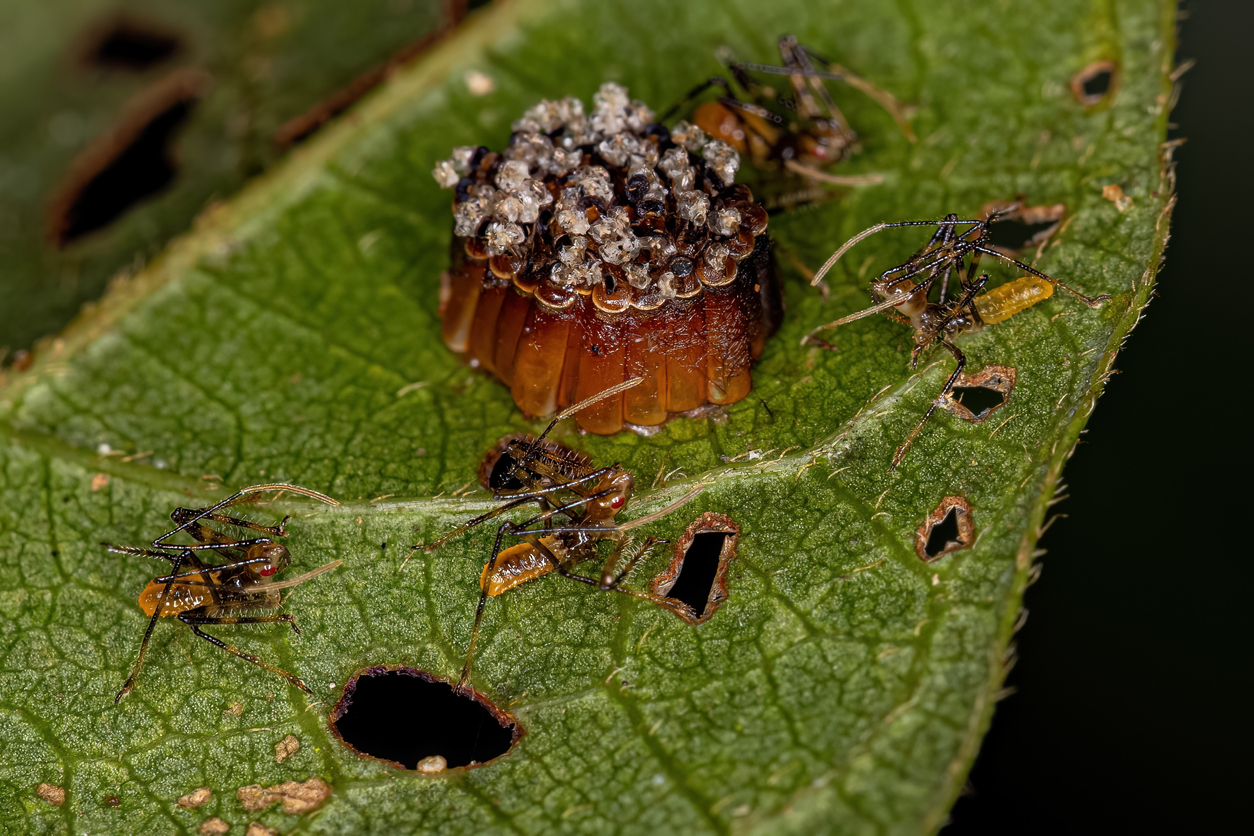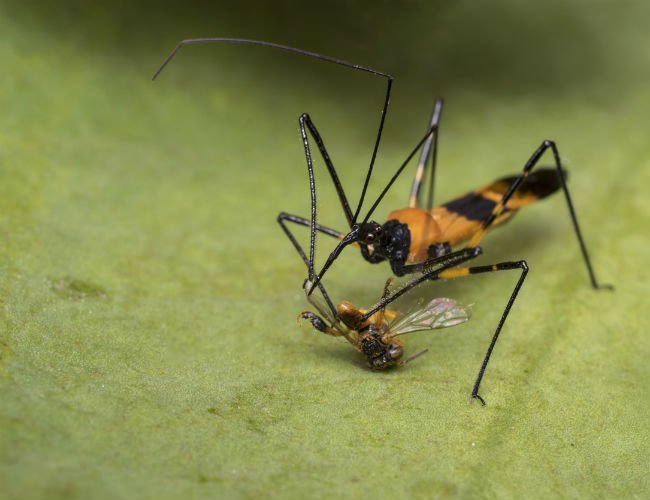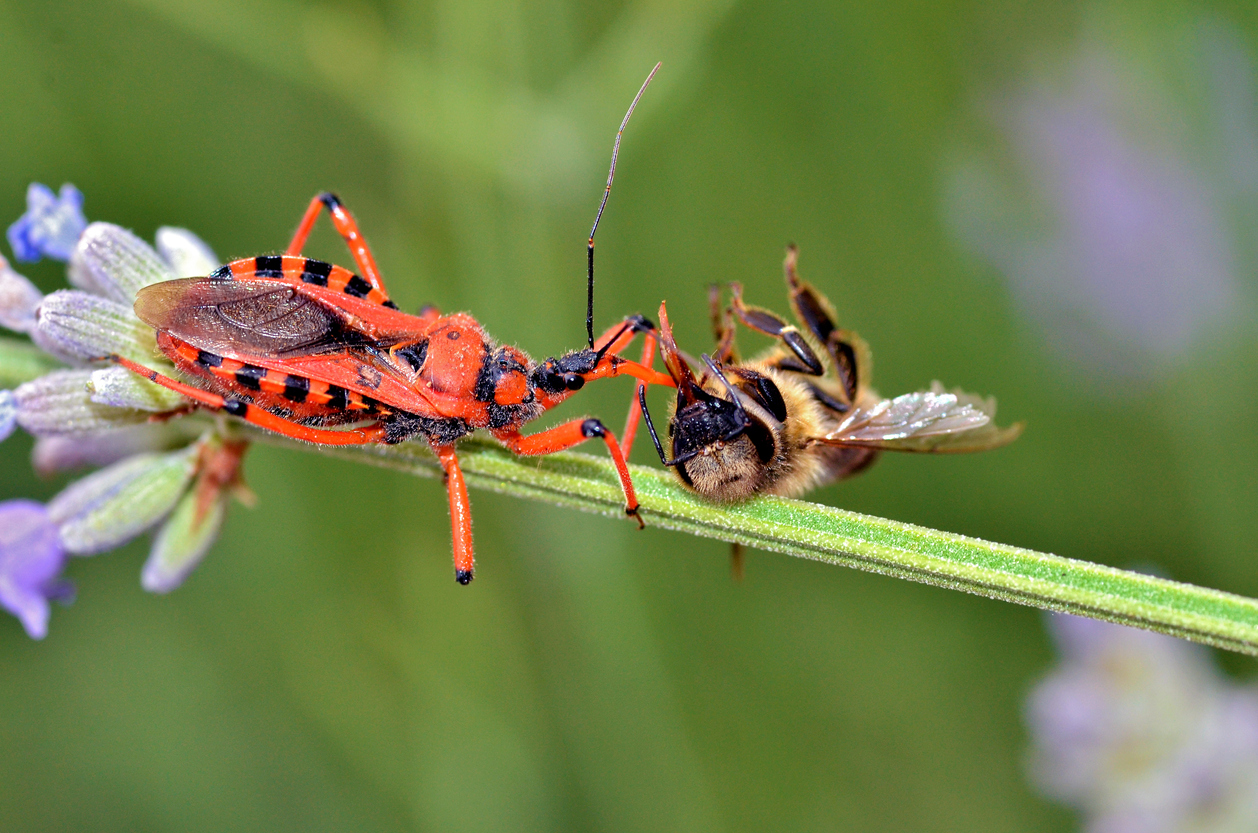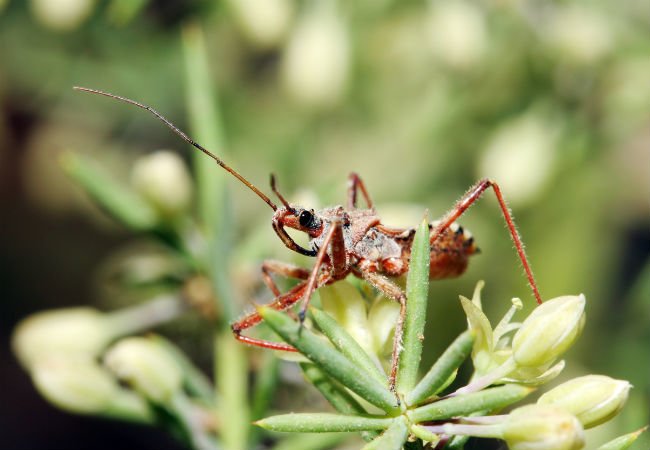We may earn revenue from the products available on this page and participate in affiliate programs. Learn More ›
The insect realm is rife with creepy-crawlies, be they smelly stink bugs, sneaky weevils, or simply slimy cockroaches. Yet certain bugs are capable of wreaking havoc in the garden, destroying harvests and stripping colorful blooms. If you spend time and money using chemical insecticides to banish bugs, you’ve probably learned to spot culprits such as aphids, squash bugs, and tomato hornworms—but you might not know about beneficial insects that prey on these pests. Like characters in an espionage novel, there’s a whole class of assassin bugs lying in wait to wallop destructive insects.
RELATED: Don’t Kill These 17 Beneficial Insects in Your Garden
What is an assassin bug?
“Assassin bug” is the common name for a large portion of insects that make up the Reduviidae family. North America is home to about 160 species of assassin bug, though there are about 7,000 species worldwide. Assassin bugs use a curved, dagger-like mouthpart known as a rostrum or proboscis to kill prey. An assassin bug spears its victim, injects lethal venom or digestive juices to kill it, and then sucks on the prey to feed. These bugs also use this beak to defend themselves from predators. These bugs devour destructive aphids, leafhoppers, and caterpillars, and can even consume insects larger than themselves. What’s more, assassin bugs actively hunt their prey, patrolling trees, bushes, and other vegetation for victims. No wonder experienced gardeners view them as friends, especially those who take a natural approach and like to limit their use of pesticides.
What do assassin bugs look like?

If you’re wondering if the bugs in your garden are assassin bugs, look for these identifiable characteristics:
- These insects have a rostrum, which is a sharp, three-segmented, hollow beak.
- As adults, their bodies range from about ½ to 1¼ inches in length.
- Many are brown, gray, or black, although some are brightly colored or have bright red, orange, or green areas on their bodies.
- They have round, beady, protruding eyes that help them spot prey.
- They have a long, narrow, tubular head that gives them the appearance of having a neck.
- Their legs tend to be longer than those of many other insects.
- While they have wings and can fly, they tend to be poor flyers.
Identifying Species of Assassin Bugs
Because there are so many kinds of assassin bugs, these insects are often confused with other invertebrates that are not a gardener’s friend. When scouting your landscape for hungry helpmates, consider these clarifications to know what is—and isn’t—an assassin bug.
| Type of Bug | Description |
| The Wheel Bug |

The most common and readily recognizable assassin is the wheel bug. At 1¼ inches long, wheel bugs are the largest type of assassin bug in North America, gray in color and sporting a raised semicircular crest on its back that resembles a wheel with protruding spokes. Dr. Michael J. Raupp, entomologist at the University of Maryland, dubs the wheel bug “the lion or the eagle of your food web,” and calls its presence evidence of “a very healthy landscape.” Ambush Bugs

Photo: istockphoto.com Another type of assassin bug is the ambush bug, which has a stouter body that’s typically bright yellow, red, or orange. These bugs also have thicker front legs that they use to help capture and hold down prey. Another distinguishing characteristic of ambush bugs is that they tend to sit among flowers and wait for victims to come their way. Other types of assassin bugs, like the milkweed assassin bug, actively hunt on different types of vegetation.
Other Bugs Sometimes Confused With Assassin Bugs
| Type of Bug | Description |
| Kissing Bugs |

Another group of bugs in the Reduviidae family are members of a Reduviidae subfamily, Triatominae, and are commonly called “kissing bugs,” though they are sometimes lumped in with assassin bugs. Kissing bugs feed on the blood they suck out of victims, typically humans and other vertebrates. Also called conenose bugs or vampire bugs, Triatominae are known for their spread of a parasite that causes Chagas disease, also known as American trypanosomiasis. Chagas disease is an inflammatory, infectious disease that, left untreated, can lead to heart and digestive problems and even death. Kissing bugs, so named because they are attracted to the carbon dioxide humans expel from their mouths, are not a beneficial bug.
The Leaf-Footed Bug

Bugs in the Coreidae family are commonly referred to as leaf-footed bugs. While they have the piercing and sucking mouthparts that assassin bugs do, leaf-footed bugs, in both their nymphal and adult life stages, damage plants, feeding on juices from leaves, shoots, stems, and fruit. Leaf-footed bugs can ravage the likes of vegetables, citrus, and row crops, as well as ornamental plants and weeds.The Western Conifer Seed Bug

Among the leaf-footed bugs in the Coreidae family is the western conifer seed bug, whose appearance means it’s often mistaken for the wheel bug. The western conifer seed bug makes a buzzing noise in flight and can emit a noxious odor, just like a stink bug. It feeds primarily on resinous plants, particularly the sap of developing conifer cones.
Where do assassin bugs live?
With thousands of species of assassin bugs, it’s no surprise to learn that their habitats are varied. Assassin bugs can be found everywhere from rainforests to rocky areas, though many species thrive in moist environments. You may spot them around your property in wood piles, animal nests, and chicken coops. In terms of vegetation, assassin bugs range freely in any number of types of plants, and, except for ambush bugs, which are drawn to flowers, they don’t prefer any particular type of plant. They’re found in orchards, vegetable gardens, ornamental flower beds—virtually everywhere their prey may be. That’s why they’re so beneficial for natural pest control. If you have a garden, even a small one, or a few outdoor container plants, odds are assassin bugs will come to dine.
RELATED: 8 Pest-Control Myths You Shouldn’t Believe
Assassin Bug Life Cycle

While the incubation time of eggs and metamorphosis of the assassin bug nymph (immature bugs) differs among species, many assassin bugs in North America share a life cycle pattern:
- They breed in autumn. The female deposits clumps of fertilized eggs under leaves, on stems, and in the crevices of plants.
- The eggs hatch into wingless nymphs the following spring.
- Nymphs undergo several growing stages, each one accompanied by the shedding of skin (molting).
- By summer, the assassin bug will have grown wings and reached adulthood.
Assassin bugs are resilient: Nymphs, adults, and eggs can all survive temperatures below zero. Assassin bugs are capable of living for several years.
How Assassin Bugs Hunt
Assassin bugs have voracious appetites. These adept predators may also use ploys to attract victims, such as coating their forelegs with sap or leaving the carcass of a dead bug as bait to lure a live one. Other times, the assassin bug hides under a rock or piece of bark, creeps up on its victim, then quickly snatches it with its front legs, which in some species have sticky hairs that help snare prey. Ambush bugs are a bit lazier. Brightly colored to blend in with flower petals or leaves, they lie in wait for prey to approach, then go in for the kill. Next, the assassin bug pierces the body of its prey with its needle-sharp proboscis and injects a toxin that kills within seconds. The toxin also liquefies the insides of the victim, which the assassin bug sucks up through its hollow rostrum. When done feeding, it leaves behind just an empty shell. Assassin bugs can also use their long rostrums in self-defense, stabbing enemies such as birds and even squirting venom as far as an inch.
What do assassin bugs eat?

Assassin bugs have a highly diverse invertebrate diet, feasting on everything from tiny aphids to large caterpillars and just about any bug in between. Thanks to the way they slurp up nutrients through the rostrum, they can finish off a much bigger bug with ease. Assassin bugs are such indiscriminate killers, however, that they’re just as apt to go after other beneficial insects. This means the bees that pollinate and lady beetles (also known as ladybugs) that feed on small destructive insects can also become prey in the garden.
Are assassin bugs dangerous or poisonous?
Beware the assassin bug! Beneficial as they may be for protecting your garden plants, these critters may attack and bite humans and animals, but typically only if provoked, piercing the skin with that sharp beak. Though painful and likely to cause swelling at the site, an assassin bug bite, for the most part, rarely requires medical attention. If you notice an assassin bug on your body or clothing, flick it off to remove it. Smashing it into your skin almost guarantees you’ll receive a painful bite for your efforts.
How to Attract Assassin Bugs
Assassin bugs can be a natural gardener’s best friend, controlling detrimental insects without chemical pesticides. To help them help you, try these tips:
- Illuminate your outdoor space. Many assassin bugs are attracted to light.
- Provide an oasis. Put some small stones or gravel in a small pan, and half-fill it with water. This way, assassin bugs can perch on the rocks to drink water without falling in and drowning.
- Add mulch. Some assassin bugs are on the shy side and seek cover. Mulch offers them a place to hide out.
- Kill carefully. If you must use pesticide to combat a particular infestation, choose a narrow-spectrum pesticide designed to kill only a specific type of insect. A narrow-spectrum pesticide that kills only ants, for example, won’t harm assassin bugs.
- Fill in with flowers. Some assassin bugs are attracted to flowers, so entice them into a veggie patch by planting a few prolific bloomers like marigolds or tansy among the rows of cucumbers and peppers. Herbs such as fennel and dill may also tempt assassins.
Final Thoughts

Assassin bugs can be used as a method of controlling destructive insects without chemical pesticides. However, when considering whether to take steps to attract these bugs, consider that they are indiscriminate predators and will eat beneficial insects such as bees and ladybugs. If you have an abundance of pollinators, you might be OK inviting the assassins in to take care of bad bugs, but it makes sense to evaluate your overall environment before making any decisions.


